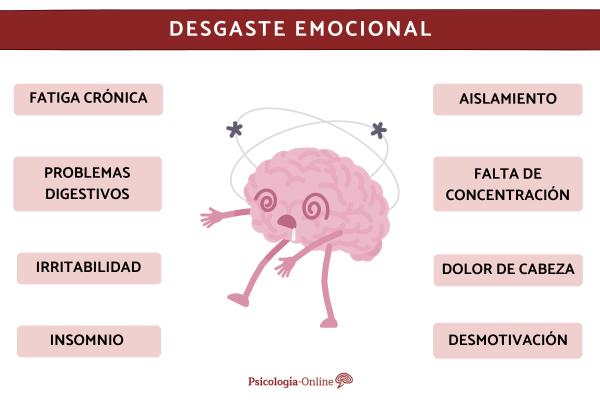Burnout is a state of mental and physical exhaustion caused by prolonged stress and intense emotional demands. It can cause irritability, demotivation and insomnia. It is common in professions that involve a high level of interaction with people, such as healthcare, education, and social services, although it can affect anyone who experiences high levels of stress over a prolonged period.
It is a serious condition that can severely affect quality of life and overall health, so identifying the symptoms of emotional burnout and taking steps to manage them is crucial to maintaining emotional and physical well-being. In this PsychologyFor article, we will provide you with information about emotional burnout: causes, symptoms and treatment.
What is emotional burnout syndrome?
Emotional exhaustion syndrome, also known as “burnout” or professional exhaustion syndrome, is a state of physical, emotional and mental exhaustion caused by prolonged and excessive stress in the workplace. In global terms, this clinical picture is used in the workplace to emphasize the difficulties involved in carrying out specific tasks.
This condition manifests itself in those moments when a person cannot adequately cope with the demands and demands they receive from their environment. This syndrome is recognized by the World Health Organization (WHO) as a occupational phenomenon that affects millions of workers Worldwide.
Causes of emotional exhaustion
Emotional burnout can be caused by multiple factors that cause chronic and accumulated stress. Here we detail the most common causes:
- Work overload : Having more work than you can reasonably handle can lead to burnout. Working too many hours without adequate rest can cause emotional exhaustion.
- Lack of control : feeling of having little or no influence over work-related decisions, time organization and task assignment, which can cause helplessness and frustration.
- Lack of support : absence of emotional and professional support from colleagues, superiors and the organization in general, which can increase isolation and stress.
- Interpersonal conflicts : tense or conflictive relationships with co-workers, superiors or clients, which can generate a hostile work environment and increase emotional stress.
- Lack of recognition and personal advancement l: feeling that achievements and potential for professional growth and development within the organization are not adequately recognized.
- Intense emotional demands : high emotional demands at work, especially in professions that involve caring for and caring for people, which can exhaust each person’s emotional resources. In this article we explain how to deal with emotional overload.
- High expectations : Pressure to meet high standards of performance, often self-imposed or expected by the organization, which can lead to dissatisfaction and burnout.

Symptoms of emotional exhaustion
Emotional exhaustion manifests itself through a variety of symptoms that can affect both mental and physical health. Recognizing them is crucial to take preventive and early intervention measures. Below, we present the most common symptoms of emotional exhaustion:
- Chronic fatigue : Constant feeling of tiredness and lack of energy, even after periods of rest. This fatigue affects the ability to perform daily activities and decreases productivity.
- Lack of will and demotivation : Loss of interest and enthusiasm for activities you previously enjoyed, both at work and in your personal life, which decreases performance and overall satisfaction.
- Irritability : increased sensitivity and reduced tolerance to situations that would not normally cause discomfort. This causes constant mood swings and disproportionate responses to small conflicts.
- Changes in sleep patterns : problems falling or staying asleep, as well as waking up frequently during the night, which causes fatigue and decreases physical and mental recovery capacity.
- Social isolation : tendency to avoid social interactions and feel disconnected from others. This can make you feel alone and exacerbate emotional stress. In this article you will see what are the consequences of social isolation.
- Difficult to focus : Problems focusing and maintaining attention on specific tasks, leading to frequent forgetfulness and errors at work or in daily life.
- physical problems : appearance of physical symptoms such as headaches, digestive problems and other ailments without an apparent medical cause, often caused by accumulated stress and tension.
The isolated presence of any of these symptoms is not synonymous with emotional burnout syndrome, but it is necessary for a mental health professional to make the diagnosis. Identifying and understanding these symptoms is essential to managing emotional burnout.
Treatment of emotional exhaustion
Treating burnout requires a comprehensive approach that addresses both the underlying causes and symptoms. Treatment strategies may vary depending on the severity of the emotional burnout and individual circumstances, but generally include the following types of interventions:
Psychological therapy
Psychological therapy for emotional burnout focuses on identify and treat symptoms of burnout, as well as developing effective strategies to deal with it. Approaches such as Cognitive Behavioral Therapy (CBT), Acceptance and Commitment Therapy (ACT), Interpersonal Therapy (IPT), and Group Therapy are particularly helpful.
- Cognitive-Behavioral Therapy (CBT) – Helps modify negative patterns of thought and behavior. In this article you will find information about Cognitive-Behavioral Therapy: what it is and what techniques it uses.
- Acceptance and Commitment Therapy (ACT) : combines acceptance and mindfulness strategies with behavior change techniques.
- Interpersonal Therapy (IPT) : improves interpersonal relationships and communication, essential for emotional well-being.
- Group Therapy – Provides a supportive environment where you can share experiences and learn from others.
These therapeutic approaches seek to reduce stress and improve mental health through the development of practical skills and cognitive restructuring.
Drug therapy
Drug therapy can be an effective part of treatment for emotional burnout, especially when symptoms are severe and significantly affect quality of life. However, their consumption must be supervised by a specialized mental health professional.
Furthermore, it is recommended combine drug therapy with psychological interventions and lifestyle changes to comprehensively address the causes and symptoms of burnout. Below, we show you the most recommended drugs for emotional exhaustion:
- Antidepressants : such as fluoxetine and sertraline, which increase serotonin levels in the brain.
- Anxiolytics : benzodiazepines such as diazepam and lorazepam, or buspirone, a non-benzodiazepine anxiolytic that has a lower risk of dependence.
- Melatonin : a supplement that regulates the sleep cycle and is useful in improving the quality of sleep without causing side effects.

This article is merely informative, at PsychologyFor we do not have the power to make a diagnosis or recommend a treatment. We invite you to go to a psychologist to treat your particular case.
If you want to read more articles similar to Emotional exhaustion: causes, symptoms and treatment we recommend that you enter our Clinical Psychology category.
Bibliography
- Martínez Pérez, A. (2010). Burnout syndrome. Conceptual evolution and its current state of affairs. Vivat Academia Magazine, 112 (12), 42-80.









